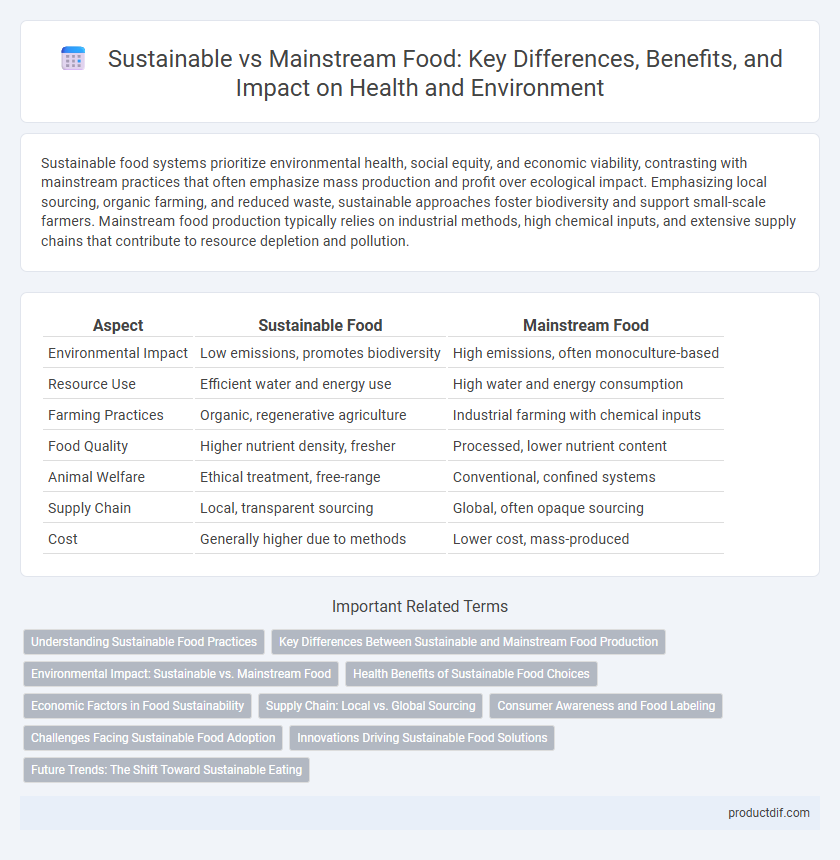Sustainable food systems prioritize environmental health, social equity, and economic viability, contrasting with mainstream practices that often emphasize mass production and profit over ecological impact. Emphasizing local sourcing, organic farming, and reduced waste, sustainable approaches foster biodiversity and support small-scale farmers. Mainstream food production typically relies on industrial methods, high chemical inputs, and extensive supply chains that contribute to resource depletion and pollution.
Table of Comparison
| Aspect | Sustainable Food | Mainstream Food |
|---|---|---|
| Environmental Impact | Low emissions, promotes biodiversity | High emissions, often monoculture-based |
| Resource Use | Efficient water and energy use | High water and energy consumption |
| Farming Practices | Organic, regenerative agriculture | Industrial farming with chemical inputs |
| Food Quality | Higher nutrient density, fresher | Processed, lower nutrient content |
| Animal Welfare | Ethical treatment, free-range | Conventional, confined systems |
| Supply Chain | Local, transparent sourcing | Global, often opaque sourcing |
| Cost | Generally higher due to methods | Lower cost, mass-produced |
Understanding Sustainable Food Practices
Sustainable food practices prioritize eco-friendly methods such as organic farming, reduced pesticide use, and regenerative agriculture to minimize environmental impact and enhance biodiversity. These approaches emphasize local sourcing, seasonal eating, and waste reduction to support long-term food system resilience. In contrast, mainstream food production often relies on intensive monoculture, synthetic inputs, and global supply chains that contribute to soil degradation and higher carbon footprints.
Key Differences Between Sustainable and Mainstream Food Production
Sustainable food production prioritizes environmental health by utilizing practices such as crop rotation, reduced chemical inputs, and organic fertilizers, which help maintain soil fertility and biodiversity. In contrast, mainstream food production often relies on intensive monoculture, synthetic pesticides, and fertilizers to maximize yield, frequently leading to soil degradation and ecosystem imbalance. Key differences include resource efficiency, impact on ecosystems, and long-term viability, with sustainable methods aiming to minimize carbon footprint and water use compared to conventional agriculture.
Environmental Impact: Sustainable vs. Mainstream Food
Sustainable food systems prioritize reducing greenhouse gas emissions by promoting local sourcing, organic farming, and minimizing synthetic chemical use, significantly lowering their environmental footprint compared to mainstream food production. Mainstream agriculture often relies on intensive monoculture, heavy pesticide application, and long-distance transportation, contributing to soil degradation, biodiversity loss, and higher carbon emissions. Transitioning to sustainable food practices supports ecosystem health and climate resilience by conserving water, enhancing soil quality, and reducing harmful pollutants.
Health Benefits of Sustainable Food Choices
Sustainable food choices offer substantial health benefits by reducing exposure to harmful pesticides and synthetic chemicals commonly found in mainstream agriculture. These foods are often fresher and richer in essential nutrients like antioxidants, vitamins, and minerals, which support immune function and chronic disease prevention. Prioritizing sustainably sourced produce also promotes a more balanced diet through diverse food options derived from environmentally conscious farming practices.
Economic Factors in Food Sustainability
Sustainable food systems prioritize resource efficiency and local sourcing, reducing costs associated with transportation and waste management. Mainstream food production often benefits from economies of scale but faces hidden economic burdens like environmental degradation and health expenses. Investing in sustainable practices can lead to long-term economic resilience by supporting local economies and minimizing externalities.
Supply Chain: Local vs. Global Sourcing
Local sourcing reduces carbon emissions by minimizing transportation distances and supports regional economies through direct farmer partnerships. Global sourcing offers diverse products year-round but increases supply chain complexity and environmental impact due to long-distance shipping. Sustainable supply chains prioritize transparency, traceability, and fair labor practices while balancing ecological footprints with consumer demands.
Consumer Awareness and Food Labeling
Consumer awareness plays a crucial role in promoting sustainable food choices by encouraging demand for transparent food labeling that highlights environmental impact, organic certifications, and fair-trade practices. Mainstream food products often lack comprehensive labeling on sustainability metrics, limiting consumers' ability to make informed decisions that support eco-friendly agriculture and ethical sourcing. Enhanced food labeling standards and educational campaigns can bridge this gap, empowering consumers to prioritize sustainable options over conventional products.
Challenges Facing Sustainable Food Adoption
Sustainable food adoption faces challenges such as higher production costs, limited supply chain infrastructure, and consumer awareness gaps compared to mainstream food systems. Farmers encounter difficulties transitioning to organic or regenerative practices due to initial investment needs and knowledge barriers. Market access and price competitiveness remain critical hurdles preventing widespread adoption of sustainable food products.
Innovations Driving Sustainable Food Solutions
Innovations driving sustainable food solutions include plant-based protein alternatives, vertical farming technologies, and lab-grown meat, which significantly reduce environmental impact compared to mainstream agriculture. Advanced precision agriculture uses AI and IoT sensors to optimize resource use and minimize waste, promoting sustainability. These breakthroughs support global food security while addressing climate change challenges and conserving biodiversity.
Future Trends: The Shift Toward Sustainable Eating
Sustainable eating emphasizes plant-based diets, local sourcing, and reduced food waste to minimize environmental impact, contrasting with mainstream consumption patterns that rely heavily on processed and resource-intensive foods. Advances in alternative protein sources, such as lab-grown meat and insect-based products, are driving the shift toward more eco-friendly diets. Consumer demand for transparency, ethical sourcing, and regenerative agriculture highlights the accelerating trend toward sustainability in the global food system.
sustainable vs mainstream Infographic

 productdif.com
productdif.com